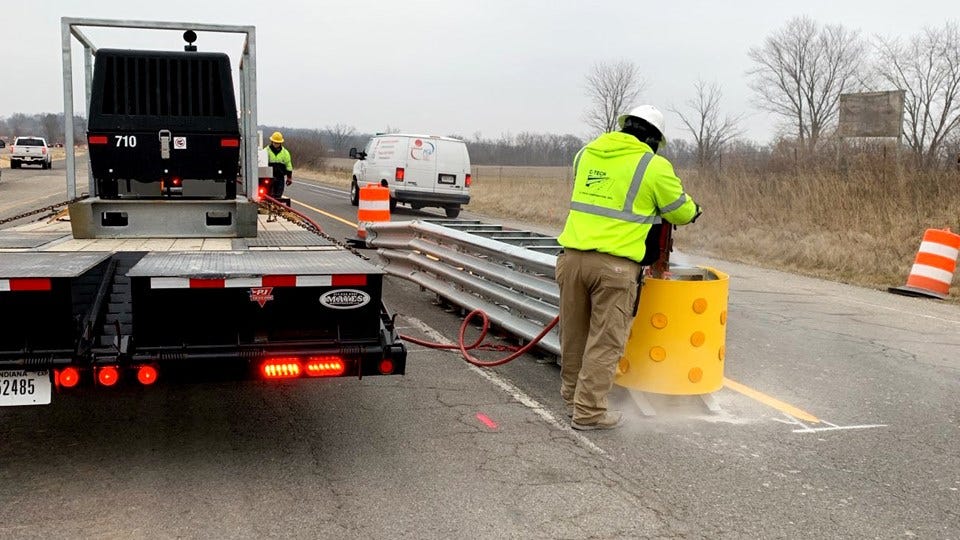Amendment to road funding bill would allow state takeover of Indy
Subscriber Benefit
As a subscriber you can listen to articles at work, in the car, or while you work out. Subscribe Now
A state lawmaker introduced an amendment Tuesday to an Indianapolis road funding bill that would allow the city to declare itself as a distressed unit of government, a move that would give the state the authority to appoint an emergency manager to oversee all aspects of the city.
Rep. Bob Behning, R-Indianapolis, authored the amendment, which would add a new clause to the definition of a distressed asset, stating that any municipality that is at least $1 billion behind in funding its critical infrastructure needs can declare such status.
A report from Indianapolis-based engineering firm HNTB Corp. using 2019 data found the city would need $635 million in additional annual funding to maintain its roads.
Adjusted for inflation and increased construction costs, that amount would approach about $1 billion in 2023, Behning said.
“If you talk to [the Indiana Department of Transportation], they will tell you that our costs are up almost 40% over what they were just several years ago,” Behning said.
In its original version, Senate Bill 283, authored by Sen. Aaron Freeman, R-Indianapolis, which passed the Senate last month by a 48-0 vote, would allocate an additional $8 million in annual road funding to the city by including about 196,000 residents in Decatur, Pike and Wayne townships as part of the city’s population.
Those townships weren’t taken into account in the city’s share of state road funding due a technical error dating back to the consolidation of city and county government in 1970, Freeman said.
Behning’s amendment would keep that provision of the bill. He said the distressed declaration would “allow the city to leverage more resources” to pay for infrastructure costs, including taking up to 20% of its tax increment funding to put toward road funds, enacting a $50 vehicle registration fee and raising its wheel tax.
But city officials, local government advocates and several Democrats serving on the House Roads and Transportation committee voiced deep concerns Tuesday over the language in the amendment.
Dan Parker, the city’s deputy mayor and former head of public works, said it would amount to a massive tax increase for Marion County residents and put the city’s financial reputation at risk.
“Indianapolis is the economic engine of the state of Indiana. Indianapolis is not a distressed unit,” Parker told the committee. “We’ve invested in our infrastructure without selling off assets or raising taxes.”
Taylor Hughes, vice president of policy and strategy for the Indy Chamber, said declaring distressed status would hinder the city’s ability to attract economic development.
“We think a distressed status candidly sends a pretty strong and negative message to potential investors that this isn’t a good place to put your money or expand your operations,” Hughes told the committee.
Behning said the intent of his amendment was not to allow the state to take over the city but to “provide more flexibility in terms of access to additional resources to meet their needs.”
Jenna Bentley, director of government affairs for Accelerate Indiana Municipalities, a group representing the interests of cities and towns, said distressed status should only be used “as a last resort” and urged the committee to consider other options.
One of those options is changing the state’s road funding formula to be based on vehicle miles traveled instead of center-line miles, which disproportionately benefits rural areas with fewer lanes of traffic. Center-line miles simply measure the length of a road, while vehicle miles traveled per capita is calculated as the total annual miles of vehicle travel divided by the total population in a particular region.
Committee chair Rep. Jim Pressel, a Republican from rural northwestern Indiana, said he isn’t inclined to consider such a change.
“I don’t think there are votes in this body to make that happen,” Pressel told reporters following the hearing. “So let’s just cast that aside. Let’s quit talking about it and figure out some new solutions.”
Pressel said the distressed status amendment is “not going to go forward” but there might be other amendments considered at the committee’s next hearing.
City officials have tried for years to get the state to change its road funding formula, arguing that it doesn’t take into account the 166,000 people who live outside of the county but commute to Indy for work.
In hopes of building a broader coalition, the city commissioned a study that found the eight “donut” counties surrounding Marion—whose cities have seen tremendous growth in recent decades, leading to greater traffic volumes and wider roads—also stand to lose out on road funding under the current model.
The study by Indianapolis-based Policy Analytics also found the eight suburban counties in the Indianapolis metropolitan statistical area fell in the bottom third in terms of funding by local vehicle miles traveled. Ohio County, the smallest and least populous county in the state, received the most funding under that model.
But the data hasn’t been enough to sway state lawmakers, particularly those in rural areas whose districts would stand to lose some funding if the formula were changed.
While Marion County maintains about 8,400 miles of roadway measured by lane miles traveled, it receives funding for only about 3,300 of those lane miles.
In 2021, the state allocated $663 million in road funding to local governments. Marion County received just over $30 million of that, or about 4.5%, despite making up about 13% of the total state population.
